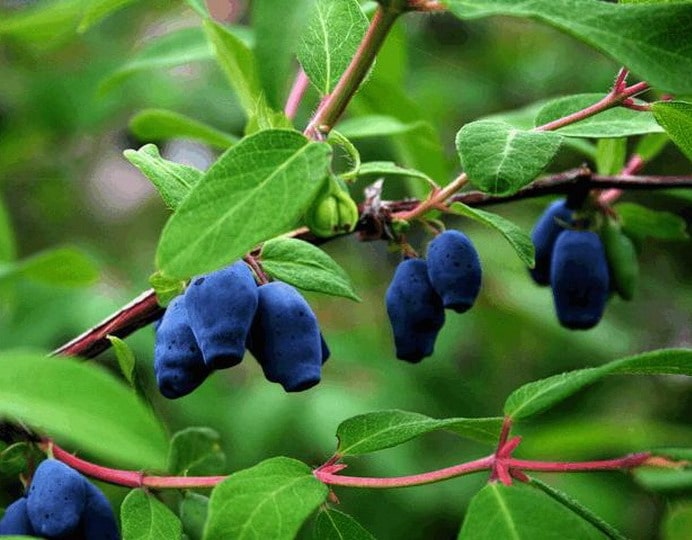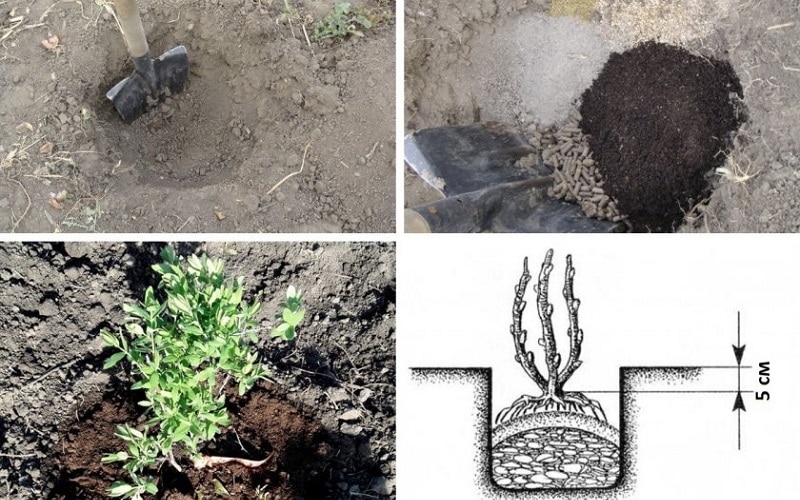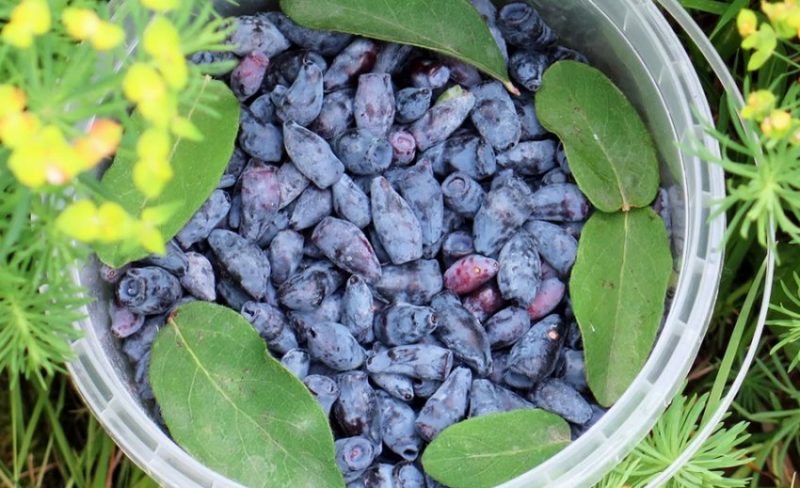Frost-resistant sweet and sour honeysuckle variety Sineglazka
There are more than 40 species of honeysuckle. All of them serve as an excellent decorative addition to garden plots and delight owners with rich harvests and juicy berries. Such a variety of varieties allows you to choose a suitable specimen, taking into account taste preferences and climatic features. In this article we will look at the honeysuckle variety Sineglazka.
Description of the honeysuckle variety Sineglazka
The variety was obtained as a result of open pollination of Smolinskaya honeysuckle. At the end of the 20th century. At the South Ural Research Institute, experimental work was carried out to develop a new species.
In 1992, the first state variety testing took place. In 1994, Sineglazka was included in the State Register and allowed for cultivation in the Ural region.

Characteristics, appearance, taste
Sineglazka is a slightly spreading bush, reaching 1.5 m in height. The shoots are thick and straight, brown-red in color. The branches are covered with a slight waxy coating, which gives the plant a dull appearance.
The berries are elongated, large, sweet and sour in taste, aromatic. According to the tasters, they scored 4.7 points.
Important! Fresh fruits contain 36 mg of vitamin C.
Features of application
The berries are good for dessert use and processing. They make excellent jams, juices, and compotes. To add flavor and color, the fruits are often added to jelly.
It is recommended to eat honeysuckle fresh.The composition contains sodium, potassium, phosphorus, magnesium, iodine, iron and silicon.
Important! A decoction of flowers and leaves is used in folk medicine as an antiseptic and disinfectant.
Productivity and fruiting
A year after planting in a permanent place, the bush begins to bear fruit. In the 4th-5th year, the yield increases, but gradually. This is due to the fact that at this age the growth of the bush slows down. In the period from 6 to 7 years, honeysuckle bears up to 1 kg of berries per bush.
The maximum number of fruits (1.5-2 kg) is collected in the 7-8th year of the plant’s life. Productivity declines after 15-17 years.
Important! Honeysuckle can live more than 20 years.
Ripening period
Sineglazka is a mid-early variety. Dark gray elongated berries can be seen on the shoots already in late May - early June. The harvest is harvested in the middle of the first summer month.
Resistance to diseases and pests
The variety is characterized by increased resistance to spotting, which does not exclude the appearance of other problems.
Among the diseases and pests that affect bushes are leaf mottling, powdery mildew, aphids, finger flies, and scale insects.
Resistance to cold and drought
The variety is characterized by high frost resistance. Flowers can withstand temperatures down to -8°C. To obtain juicy, tasty fruits during the dry period, plants need water at least once a week, taking into account natural conditions.
Important! Sineglazka can withstand frosts down to -40°C.
Suitable regions
In the CIS countries and Russia, only one species of this plant with edible berries is cultivated - blue or blue honeysuckle.
The bush feels great in the northern, southern, and central regions of the Russian Federation.
Honeysuckle Sineglazka: advantages and disadvantages
Positive properties include:
- early yield;

- good taste;
- excellent spot resistance;
- resistance to severe frosts;
- decorative appearance.
Disadvantages of the Sineglazka variety:
- low yield;
- self-sterility of the variety;
- average drought resistance.
Agricultural technology
Blue-eye is a light-loving plant, so there should be no shadow on the site. The bushes love moisture, but it is necessary to avoid its excess.
Important! With a lack of light, yields are significantly reduced.
The holes are prepared several weeks before planting - 40x40x40 cm. Values may vary depending on the development of the root system.
Preparing for landing
To obtain a well-developing and fruit-bearing bush, you should be careful when choosing a seedling:
- The plant should be no more than 2-3 years old.
- The above-ground part is without damage, with flexible green shoots and buds.
- Strong and elastic root system, densely located.
Soil requirements
An organic loamy substrate with a low groundwater level and neutral acidity is ideal. High humidity is unacceptable, as it can contribute to root rot.
Before planting, it is recommended to pour a nutrient mixture of ash, compost and superphosphate into each hole. An alternative may be complex mineral mixtures.
Dates, scheme and rules of planting

Bushes are planted in spring or autumn. The soil is first well cleared of weeds, especially perennial ones. The top layer of soil is mixed with fertilizer and poured into a mound at the bottom of the hole. Before planting, the roots of the plant are dipped in earthen mash.
The seedling is placed at the bottom of the hole, covered with earth, after straightening the root system. The soil around is trampled down, sprinkled with loose soil on top, and mulched.
Features of cultivation
This variety of honeysuckle prefers sunny places, but also tolerates partial shade. Plants planted in a dark place will not bring a large harvest.
Blue-eye is not suitable for planting on swampy soils and too dry sandy areas. When planting in the fall, you need to do it before mid-October.
In spring, the best period is considered to be the beginning of the growing season. If you are late, the honeysuckle will hurt and will not take root well.
Blue-eyed is unpretentious. Bush care is standard. Even a novice gardener will not have much difficulty following these simple rules:
- Trimming necessary for removing diseased and broken branches. Young growth growing inside the bush is also cut off.
- In the spring, fertilize with organic substances: compost, manure. It is recommended to apply ash solution and complex mineral mixtures during flowering.
- In the first year after transplantation, the plant is watered at least once a week.
- After each irrigation, the soil is mulched and loosened. The mulch is laid in a layer not exceeding 5 cm.
Pollinators
Due to self-sterility, they are planted nearby Sorceress, Chelyabinsk, Long-fruited. The main condition is the coincidence of flowering dates.
For a good harvest on your personal plot, you need to have at least 2-3 varieties of honeysuckle. Pollination occurs exclusively by cross-pollination. Without the presence of foreign pollen there will be no ovary.
Disease and pest control
Timely measures to combat diseases and pests allow you to grow a healthy crop that produces a good harvest.
Often, infections enter the garden plot along with planting material. Therefore, it is extremely important to purchase seedlings from trusted places and choose a place for planting honeysuckle, following the prescribed rules.
The variety is susceptible to such misfortunes as:
- Cancer (common or European). It appears as irregularities on the bark with the formation of cracks. After a certain time, the fungus begins to multiply in the affected tissues, and the leaves dry out. The disease cannot be treated. The affected parts are cut out and burned.
- Shchitovka. Pests suck out all the juices from the bush, which leads to its death. To solve the problem, the drugs “Actellik” and “Rogor” are used.

- Fingerwing. When attacked by insects, the berries turn blue and the pulp and seeds of the fruit are destroyed. To combat fingerfly, the drug “Inta-Vir” is used; an infusion of tomato tops is also suitable.
- Powdery mildew. A white-gray coating appears on young shoots, then fungus appears, and the surface dries out. For the fight they use “Fundazol”, “Topaz”.
Preparing for winter
Due to its high resistance to frost, the variety does not require special shelter for the winter when grown in the central regions.
It is possible to insulate the root system of young bushes in the first year after planting. To do this, cover the tree trunk area with a layer of mulch of 10-15 cm.
Reproduction
Vegetative propagation is best suited by cuttings. Take cuttings 10-12 cm long with 3 buds on the stem.
Shoots are rooted in greenhouses until their own root system develops and growth begins. Then they are planted in a permanent place.
Difficulties in growing
Honeysuckle is easy to care for, but requires compliance with standards when planting and during growth. Among the most common troubles are:
- wilting and drying of the plant;
- damage to the bush by diseases and pests;
- poor survival rate of young animals and lack of fruits;
- low yield.
Harvesting

Already at the end of May - beginning of June, the first fruits ripen on the branches. It is better to store berries in a cool place in plastic or wooden boxes with holes for air.
Important! Fresh fruits are stored for no more than 4 days.
Reviews from experienced gardeners
Summer residents note good yields and excellent taste of berries.
Irina, Moscow: “An excellent variety for growing in the north-west of Russia. It took root well, and in the second year they were already harvesting. I really like the taste, moderately sweet, with a slight sourness.”
Marina, Nizhny Novgorod: “I landscaped the garden with honeysuckle bushes. They look beautiful along the fence. Moreover, the berry is tasty and healthy. We made jam and compotes. Despite the dry weather, with increased watering, I got a great harvest this year.”
Conclusion
Honeysuckle bushes are not only a source of healthy berries, but also a wonderful decorative element in the garden. The Sineglazka variety is pleasant to taste and easy to care for.
By planting several bushes on your plot, you will enjoy their wonderful appearance for many years and enjoy sweet fruits with a slight sourness, providing yourself with a supply of vitamins for the whole year.